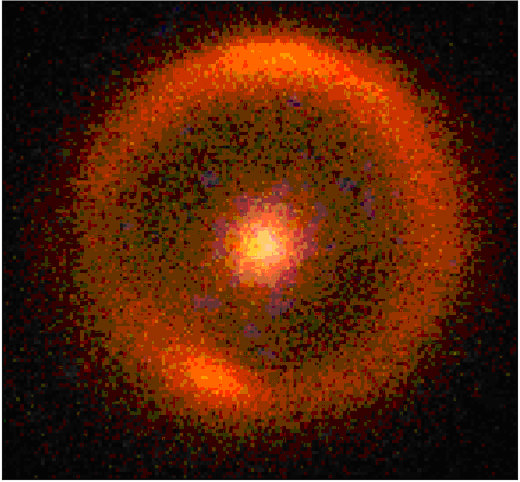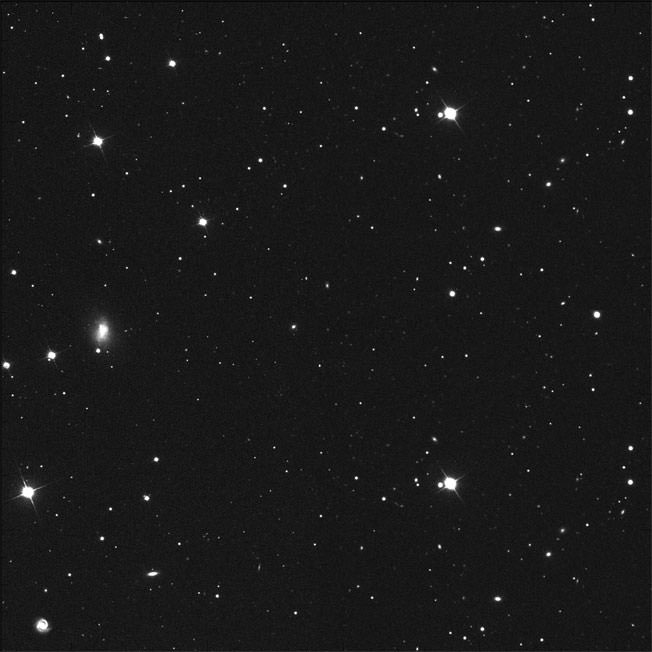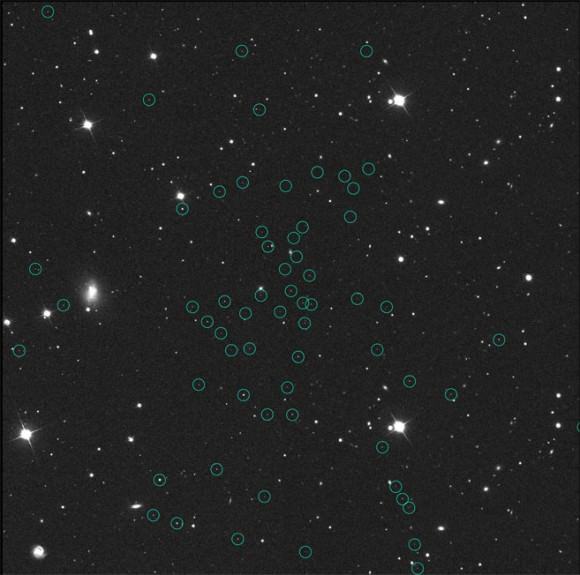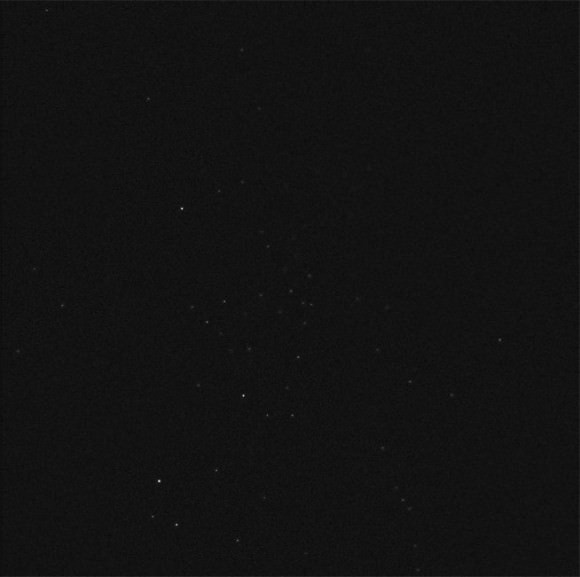Over 5,000 exoplanets have been discovered around distant star systems. Protoplanetary disks have been discovered too and it’s these, out of which all planetary systems form. Such disks have recently been found in two binary star systems. The stellar components in one have a separation of 14 astronomical units (the average distance between the Earth and Sun is one astronomical unit) and the other system has a separation of 22 astronomical units. Studying systems like these allow us to see how the stars of a binary system interact and how they can distort protoplanetary disks.
Continue reading “Astronomers See Planets Forming Around Binary Stars”Uranus has Bizarre Weather
New infrared images of Uranus show details not seen before. Credit: NASA/ESA/L. A. Sromovsky/P. M. Fry/H. B. Hammel/I. de Pater/K. A. Rages
Here’s the scene: a thick, tempestuous atmosphere with winds blowing at a clip of 900 km/h (560 mph); massive storms that would engulf continents here on Earth, and temperatures in the -220 C (-360 degree F) range. Sounds like a cold Hell, but this is the picture emerging of the planet Uranus, revealed in new high-resolution infrared images from the Keck Observatory in Hawaii, exposing in incredible detail the bizarre weather of a planet that was once thought to be rather placid.
“My first reaction to these images was ‘wow’ and then my second reaction was ‘WOW,'” said Heidi Hammel, a co-investigator on the new observations. “These images reveal an astonishing amount of complexity in Uranus’ atmosphere. We knew the planet was active, but until now much of the activity was masked by noise in our data.”
Voyager 2’s view of Uranus. Credit: NASA
With its beautiful blue atmosphere, Uranus can seem rather tranquil at first glance. Even the flyby of Voyager 2 in 1986 revealed a rather “bland” blue ball. But coming into focus now with the new are large weather systems, and even though they are probably much less violent than storms on Earth, the weather on Uranus is just…bizarre.
“Some of these weather systems,” said Larry Sromovsky, from the University of Wisconsin-Madison who led the new study using the Keck II telescope, “stay at fixed latitudes and undergo large variations in activity. Others are seen to drift toward the planet’s equator while undergoing great changes in size and shape. Better measures of the wind fields that surround these massive weather systems are the key to unraveling their mysteries.”
Sromovsky, Hammel and their colleagues are using new infrared techniques to deliver some of the “most richly detailed views of Uranus yet obtained by any instrument on any observatory. No other telescope could come close to producing this result,” Sromovsky said.
What they are seeing are previously undetected, small but widely distributed weather feature, and they hope the movements of these features can help make sense of the planet’s odd pattern of winds.
They observed a scalloped band of clouds just south of Uranus’ equator and a swarm of small convective features in the north polar regions of the planet. Features like this don’t seem to be in the southern polar regions, but are similar to the types of “popcorn” –type clouds seen on Saturn. Uranus’ north pole is not visible from Earth night now, but when it does come into view, the researchers wouldn’t be surprised to see a polar vortex feature similar to what has been seen at Saturn’s south pole.
The driver of these features must be solar energy because there is no other detectable internal energy source.
“But the Sun is 900 times weaker there than on Earth because it is 30 times further from the Sun, so you don’t have the same intensity of solar energy driving the system,” said Sromovsky. “Thus the atmosphere of Uranus must operate as a very efficient machine with very little dissipation. Yet the weather variations we see seem to defy that requirement.”
One possible explanation, is that methane is pushed north by an atmospheric conveyor belt toward the pole where it wells up to form the convective features visible in the new images. The phenomena may be seasonal, the team said, but they are still working on trying to put together a clear seasonal trend in the winds of Uranus.
“Uranus is changing,” he said, “and there is certainly something different going on in the two polar regions.”
The images were released at the American Astronomical Society’s Division for Planetary Sciences meeting taking place this week.
Source: University of Wisconsin-Madison
Distant Invisible Galaxy Could be Made Up Entirely of Dark Matter

[/caption]
Astronomers can’t see it but they know it’s out there from the distortions caused by its gravity. That statement describes dark matter, the elusive substance which scientists have estimated makes up about 25% of our universe and doesn’t emit or absorb light. But it also describes a distant, tiny galaxy located about 10 billion light years from Earth. This galaxy can’t be seen in telescopes, but astronomers were able to detect its presence through the small distortions made in light that passes by it. This dark galaxy is the most distant and lowest-mass object ever detected, and astronomers say it could help them find similar objects and confirm or reject current cosmological theories about the structure of the Universe.
“Now we have one dark satellite [galaxy],” said Simona Vegetti, a postdoctoral researcher at the Massachusetts Institute of Technology, who led the discovery. “But suppose that we don’t find enough of them — then we will have to change the properties of dark matter. Or, we might find as many satellites as we see in the simulations, and that will tell us that dark matter has the properties we think it has.”
This dwarf galaxy is a satellite of a distant elliptical galaxy, called JVAS B1938 + 666. The team was looking for faint or dark satellites of distant galaxies using gravitational lensing, and made their observations with the Keck II telescope on Mauna Kea in Hawaii, along with the telescope’s adaptive optics to limit the distortions from our own atmosphere.
They found two galaxies aligned with each other, as viewed from Earth, and the nearer object’s gravitational field deflected the light from the more distant object (JVAS B1938 + 666) as the light passed through the dark galaxy’s gravitational field, creating a distorted image called an “Einstein Ring.”
Using data from this effect, the mass of the dark galaxy was found to be 200 million times the mass of the Sun, which is similar to the masses of the satellite galaxies found around our own Milky Way. The size, shape and brightness of the Einstein ring depends on the distribution of mass throughout the foreground lensing galaxy.
Current models suggest that the Milky Way should have about 10,000 satellite galaxies, but only 30 have been observed. “It could be that many of the satellite galaxies are made of dark matter, making them elusive to detect, or there may be a problem with the way we think galaxies form,” Vegetti said.
The dwarf galaxy is a satellite, meaning that it clings to the edges of a larger galaxy. Because it is small and most of the mass of galaxies is not made up of stars but of dark matter, distant objects such as this galaxy may be very faint or even completely dark.
“For several reasons, it didn’t manage to form many or any stars, and therefore it stayed dark,” said Vegetti.
Vegetti and her team plan to use the same method to look for more satellite galaxies in other regions of the Universe, which they hope will help them discover more information on how dark matter behaves.
Their research was published in this week’s edition of Nature.
The team’s paper can be found here.
Sources: Keck Observatory, UC Davis, MIT
Alone In The Dark?

[/caption]
Two years ago, Marla Geha, a Yale University astronomer, Joshua Simon from the Carnegie Institution of Washington, and their colleagues discovered something unusual while studying with the Keck II telescope and information for the Sloan Digital Sky Survey. Their observations turned up a contrasting group of stars which all appeared to be moving in unison – not just a moving cluster of similar stars which could have been torn away from the nearby Sagittarius dwarf galaxy. The team knew they were on to something, but a competing group of astronomers at Cambridge University was skeptical. Too bad… there was a dark treasure right there before their eyes.
Not to be dissuaded, Simon, Geha and their group returned to Keck and turned the photographic eye of the telescope’s Deep Extragalactic Imaging Multi-Object Spectrograph (DEIMOS) towards their target area. Even though it was only about 1,000 small, dim stars, they wanted to know how they migrated both in respect to the Milky Way and to each other. Named Segue 1, the target the team was looking at could possibly have 3,400 times more mass than can be accounted for by its visible stars… a galaxy dominated by dark matter and salted with a handful of ancient suns. If the 1,000 or so stars were all there was to Segue 1, with just a touch of dark matter, the stars would all move at about the same speed, said Simon. But the Keck data show they do not. Instead of moving at a steady 209 km/sec relative to the Milky Way, some of the Segue 1 stars are moving at rates as slow as 194 kilometers per second while others are going as fast as 224 kilometers per second.

“That tells you Segue 1 must have much more mass to accelerate the stars to those velocities,” Geha explained. The paper confirming Segue 1’s dark nature appeared in the May 2011 issue of The Astrophysical Journal. “The mass required to cause the different star velocities seen in Segue 1 has been calculated at 600,000 solar masses. But there are only about 1,000 stars in Segue 1, and they are all close to the mass of our Sun,” Simon said. “Virtually all of the remainder of the mass must be dark matter.”
But the information from DEIMOS didn’t stop there… It also revealed an eclectic collection of nearly primordial metal-poor stars. The researchers managed to gather iron data on six stars in Segue 1 with the Keck II telescope, and a seventh Segue 1 star was measured by an Australian team using the Very Large Telescope. Of those seven, three proved to have less than one 2,500th as much iron as the Sun. “That suggests these are some of the oldest and least evolved stars that are known,” said Simon. This is fascinating data considering investigations for stars of this type out of the Milky Way’s billions have produced less than 30. “In Segue 1 we already have 10 percent of the total in the Milky Way,” Geha said. “For studying these most primitive stars, dwarf galaxies are going to be very important.”

By confirming Segue 1’s massive concentration of dark matter, other types of research into this dark galaxy’s lifestyle now become more dedicated. The space-based Fermi Gamma Ray Telescope has also been looking its way in hopes of catching a gamma-ray event created by the collision and annihilation of pairs of dark matter particles. So far the Fermi telescope has not detected anything of the sort, which isn’t entirely surprising and doesn’t mean the dark matter isn’t there, said Simon.
“The current predictions are that the Fermi telescope is just barely strong enough or perhaps not quite strong enough to see these gamma rays from Segue 1,” Simon explained. So there are hopes that Fermi will detect at least the hint of a collision. “A detection would be spectacular,” said Simon. “People have been trying to learn about dark matter for 35 years and not made much progress. Even a faint glow of the predicted gamma rays would be a powerful confirmation of theoretical predictions about the nature of dark matter.”
Let’s hope Segue 1 isn’t alone in the dark.
Original News Source: Keck Observatory Science News.



